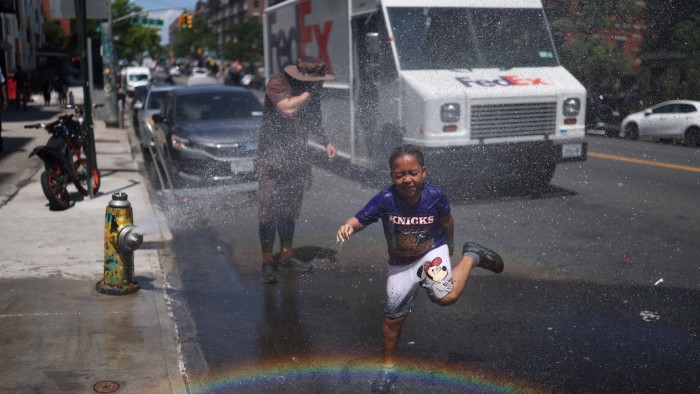Stay informed with free updates
Simply sign up to the Climate change myFT Digest — delivered directly to your inbox.
Scientists said “heat domes” and related atmospheric events behind extreme weather around the world this week had almost tripled since the 1950s, as tens of millions of people sweltered in “dangerous heat” in parts of the US and Europe.
Temperatures passed more than 40C in parts of the US as a so-called heat dome — a phenomenon that occurs when a high-pressure system traps heat — took hold across eastern and central states.
Countries including Greece, Spain and France have also faced heatwaves this month, while parts of China have been hit with severe flooding.
Even as London Climate Action Week convened, with more than 700 events taking place, the capital experienced unusually warm temperatures combined with humidity.
In Manhattan, the temperature gauge hit 99F (37.2C) on Tuesday afternoon. Kennedy Airport hit 102F.
“Dual heat domes” in both Europe and North America were likely to “become more common as we continue to heat the planet”, said Michael Mann, professor at the Department of Earth & Environmental Science at the University of Pennsylvania.
Research from Mann and colleagues, published in the journal Proceedings of the National Academy of Sciences, found that the amplification of the waves in the jet stream — the fast-moving band of air encircling the planet — had led to a dramatic increase in atmospheric events, driving heatwaves, wildfires and floods.
The phenomenon, known as quasi-resonant amplification, causes low- and high-pressure weather systems to linger over a region for longer periods.
The present “dual heat domes show that this was part of a very large scale pattern” that was linked to a “very wiggly jet stream where the ‘wiggles’ stay in place for days on end”, said Mann.

Existing climate models were “not entirely capturing the phenomenon and how it is impacted by human-caused warming”, Mann said.
The National Weather Service said midweek that the “extremely dangerous heat” would persist across the US midwest and east coast before moderating by the end of the week.
The risk of excessive rainfall and severe thunderstorms was higher in other areas, with warnings of flash flooding in New Mexico and Texas.
“This level of heat is dangerous to anyone without effective cooling and/or adequate hydration. Heat related illnesses increase significantly during extreme longer duration heat,” the NWS noted.
Climate Capital

Where climate change meets business, markets and politics. Explore the FT’s coverage here.
Are you curious about the FT’s environmental sustainability commitments? Find out more about our science-based targets here
Source link









